Inverness Deanery
Barevan
Parish Church: OS Ref: NGR NH 836472 H.E.S. No: NH84NW 6 Dedication: St Adamnán of Iona
Associated Chapels: Urchany {NGR NH 864488}; Daless (in the Streens) {NGR NH 861389}; Cawdor Castle {NGR NH 847498}; Old Calder {NGR NH }.
The ruin of this church is one of the most exquisite in Moray and its position is as romantic as one could ever wish. Its architectural style is of the First Pointed, without cusp. The building was about 65ft x 17ft and there is a plain piscina under an arch on the south side of the 'choir', close to where the altar would have stood. This church is found variously named in charters - Barrivan, Braaven, Barewan, Brearlen, Ewain, and Ewayn are but a few variations. It was the parish church till about 1619.
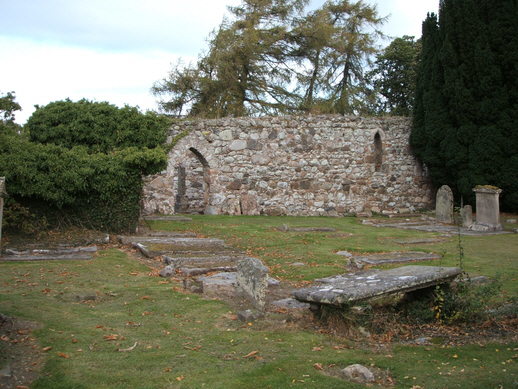
Above: Barevan Church - looking towards the south door.
There has been some debate about the dedication of Barevan. One author states that it commemmorates St Áibind of Cluain Draignech, now called St Éibhinn or Aoibhinn. This obscure saint may well be a contender, but one is left in significant doubt as to how or why his name would have become associated with this location.1 Elsewhere in Scotand we regularly find dedications to St Ewen or Evan and these are invariably translated into the commemmoration of a much more famous missionary, St Adamnán of Iona.2 An old iron bell, similar to the Ronnell Bell at Birnie church, was kept here at Barevan and is now within the safety of Cawdor Castle. Known as St Adamnán's Bell it is of square shape, of hammered iron, clasped with nails, and stood some 13" high (including its square iron handle). So precious were these relics regarded that a special keeper of them was often appointed; he was called the Dewar and his place of abode Baile-an-deoradh. A number of authors have recorded that on the approach road to Barevan Church, about a mile south of the Castle, there was a small croft which bore the name of Ballindore.11 It is supposed that this was a croft and land allocated to the Dewar who was responsible for the safe-keeping of the bell in Barevan church. We should also remember here the secular use to which these relics were put. It was not unusual in judicial cases for individuals to be sworn whilst placing their right-hand upon a 'holy relic'. The fear of the afterlife was an essential part of medieval life and it would be more than any man would dare to tell an untruth having sworn on such a 'relic' - or so it was thought! There was even a sort of unstated but well understood 'league table' of relics listing them in order of 'holiness'.
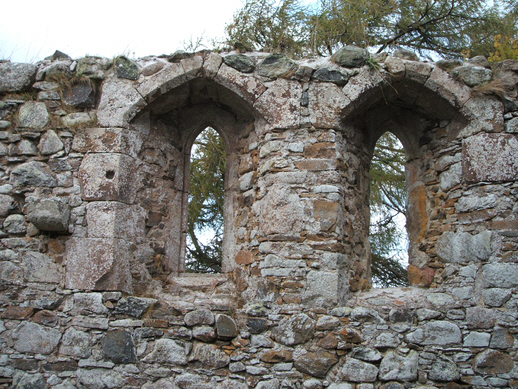
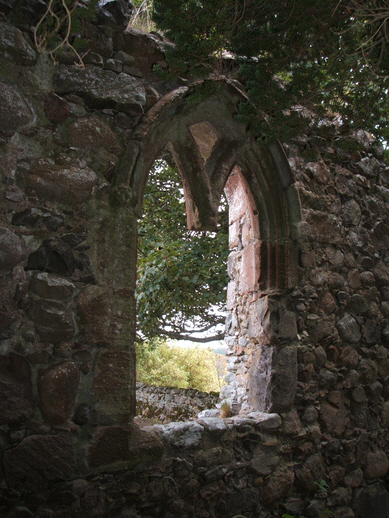
Above: Barevan Church - fine windows that contribute to dating the building.
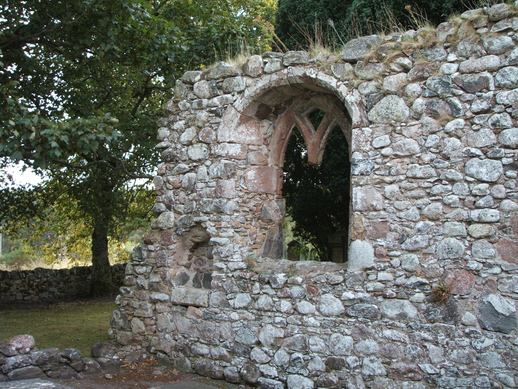
Above: Window and Piscina in the south wall of the 'choir'.
The present parish church stands some distance off in the village which is now called Cawdor but which used to be called Campbeltown. The Thanes of Cawdor have been a great power in the province since very early days and, over time, became the patrons of the churches of Ardersier, Daviot and Dorres; Urquhart in the diocese of Ross; and a number of parishes on the West coast. The Thanes of Cawdor had a special privilege from the Crown in that all of their lands, wheresoever in Scotland they lay, were considered to be within the Jurisdiction of Nairn, of which the Thanes were heritable Sheriffs.
In 1225 there appears to have been an attempt to annex the church of Evin to Scone Abbey but it seems never to have been carried through.
There is a charter of 1235 preserved in the Moray Registers which records that, on 7 August, the Bishop (Andrew de Moravia) gave the church-lands of Ewen with the lands of Budift' {Budgate? NGR NH 820474}3 to Walter de Moravia in feuferme, the latter paying 20s sterling per annum, half at Pentecost and half at Martinmas, he becoming responsible for all services (forinsec) due to the king. There is a penalty clause of 40s for non-payment.4
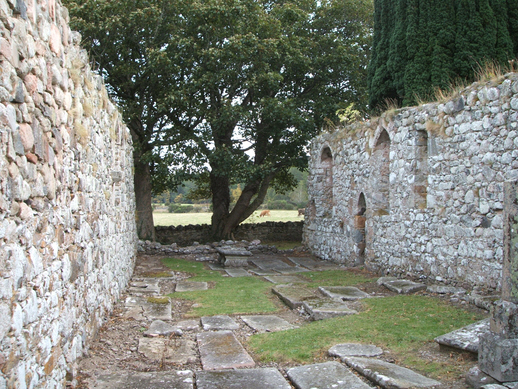
Above: The interior of Barevan Church.
In 1239, this was one the churches whose parsonage tiends Bishop Andrew de Moravia annexed to the common fund of the Cathedral Chapter - in the charter the church is called Ewain and later Ewayn. In doing so the bishop reserved to himself an unspecified proportion of the glebe lands. From that time onwards, up to the Second Reformation, Barevan was served by a vicar perpetual.5
Daless in the Streens: {NGR NH 861389} "To the south of the parish church, at Daless in the Streens, on the River Findhorn, was a chapel of ease, as it was called, which had a small glebe. The site of the chapel is still marked. It was disused after the Reformation."6 So wrote George Bain in 1928 but there are no other records of a church at Daless although it would have been an excellent site for one. The Canmore database records that "there are no traces of a graveyard or a chapel".7 Daless has offered a good and fairly reliable ford across the river from early times and it would not be surprising to find a chapel nearby. But of greater interest is the place-name Banchor somewhat downstream of Daless towards Dulsie Bridge. The word 'Banchor' often denotes a muinntir of the Early Church which was particularly famous as a place of learning. In this location it also denotes a particularly fine fishing beat known as the Banchor Beat or the Laird's Beat!
Little Urchany: About two miles distant from Barevan are the remains of another churchyard and the site of a chapel at {NGR NH 864488}. Nothing very much is known about the church although its remains were said to be still visible in 1882. In 1421, Bishop Henry (de Lichton), gave (in return for service in the Bishop's Courts at Birnie and the annual feu duty of 13s 4d) to that "noble man, Donaldo of Caldore, Thane of that Ilk, our whole land of Urchanybeg (Little Urchany) with its pertinents, lying in the Barony of Fothirves (Fothervais)," in consideration "of his advantage and support to us and our beloved Church."8 Before this date, Urchanybeg was, for many generations, the possession of the Bishops of Moray. The great antiquity of this site is proved by the nearby neolithic/Bronze Age Clava-type cairns and the cup-marked stone recovered from a farmhouse here when it fell into ruin.9 This stone is said to be one of the best examples of its kind in the country. A number of writers draw distinct parallels between the Clava Cairns and those at Little Urchany, not least that both sites seem to have hosted muinntirs of the Early Church.
Cawdor Castle: Attached to the very early residence of the Thanes of Old Cawdor was a Chapel dedicated to the Blessed Virgin Mary, and the Chaplain of Cawdor, or "The Thane's Chaplain," appears as a witness in early documents. When the 'new' Castle was built, a Chapel was included within it.
Old Calder: "About ½ mile north-east of the (parish) church of Calder, in the middle of a plot of corn land, are the walls of a church or chapel, with its burying-ground, called Old Calder. Beside it are the vestiges of the ancient seat of the Thanes of Calder, before they built the present house."10 Defensively, this was a good site since it was surrounded by boggy ground.
"In that part of the Parish of Calder which lyes upon the Water of Findhorn or Ern, are the vestiges of a church, as also a churchyard, and a glebe which payes yearly rent to the Laird of Calder."12
Clergy:
1509 (Sir) William Calder is recorded as vicar of Evan (Barevan), alive 3 January 1509.14
1. Ross, A. (2003) The Province of Moray, c.1000-1230. Unpublished PhD thesis, University of Aberdeen. Vol.1, p.85. Ross quotes this information from Watson, W.J. (1926) The History of the Celtic Place-Names of Scotland. Edinburgh. p.271, matching this Saint's name with the Gaelic Barr-?ibhinn. Clever as this may be, it does not answer the other cases at other churches, with similar names, where the dedication is known to be to St Adamnán.
2. This is found also on Deeside at the old church of Aboyne just east of Aboyne Loch which was dedicated to St Adamnán also {NGR NJ 541001}; George Bain deals with this matter in some detail in his The History of Nairnshire pp.37-38
3. This could be BUDIET = BUDYETT = BUDGATE?
4. Reg. Ep. Mor., no.87, p.100
5. Reg. Ep. Mor., no.41, p.35; Cowan Parishes, p.22
6. Bain, G. (1928) History of Nairnshire. Nairn. p.100
7. https://canmore.org.uk/site/14979/daless accessed 05/6/2019.
8. Reg. Ep. Mor., no.188, p.218 {Dated 1 March 1421, in the Chanonry of Elgin.}
9. http://canmore.org.uk/site/15019 accessed 05/6/2019.
10. Macfarlane, W. (1906) Macfarlane's Geographical Collections. Edinburgh: E.U.P. Vol.1, p.227
11. Ballindore = Gael: Baile-an-Deoradh "the dwelling of the Dewar." Bain, G. (1928) History of Nairnshire. Nairn. p.38
12. Macfarlane, W. (1906) Macfarlane's Geographical Collections. Edinburgh: E.U.P. Vol.1, p.227
14. Adam, R.J. (ed.) (1991) The Calendar of Fearn: text and additions, 1471-1667 Edinburgh: Scottish History Society. p.76
e-mail: admin@cushnieent.com
© 2019 Cushnie Enterprises
